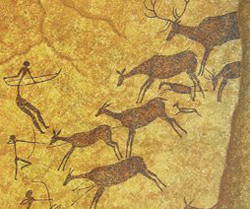
Some form of art exists everywhere on the globe, but the story of art as a continuous effort, from master to pupil, and from pupil to admirer to copyist, which links art to our own days begins in Egypt. We shall see that the greeks went to school with the Egyptians, and we are all the pupils of the Greeks.
The combination of geometric regularity and keen observation of nature is a characteristic of all ancient Egyptian art. It was the artists task to preserve everything as clearly and permanently as possible. They drew from memory with strict rules to acheive this. If we were to draw a pond near soem trees we might worry about what angle we should draw from but the egyptions drew the pond as if seen from above and the trees from the side. As you can see below they also drew the fish and birds inside the pool from the angle that would be clear to the admirer.
Egpytian art followed the similar rules for all other things including people and would forego perspective and foreshortening. We can see how all the buildings and art from egypt in this period conform to one law, we call this law - which all creative people seem to obey - a style.
Only one man shock the bars of the Egyptian style. This king, Ameniphis IV, was a heretic amd he broke many of the customs hallowed by age old tradiation. Some of his portraits show him as an ugly man and the novelty of these pictures in both subject and style must of shocked the Egyptians of his day. It is not impossible that this reform of art was made easier because he could point to foriegn work in Crete that was mush less strict and rigid.
This opening in Egyptian art did not last long and the old ways were restored during the riegn of Ameniphis' son, Tutankhamun.


